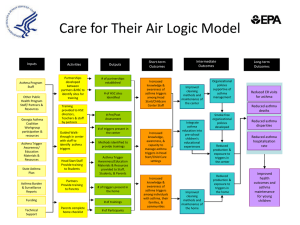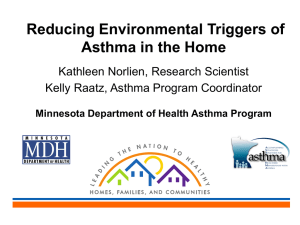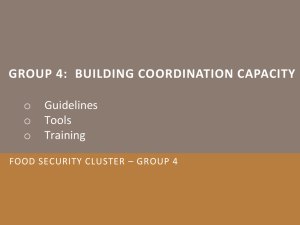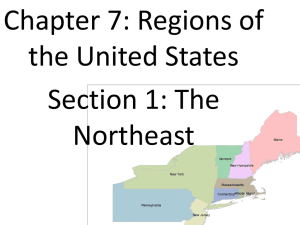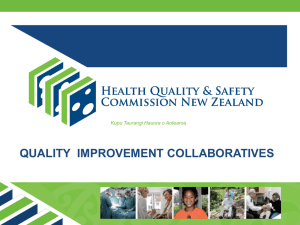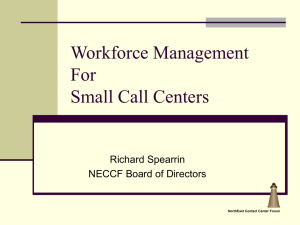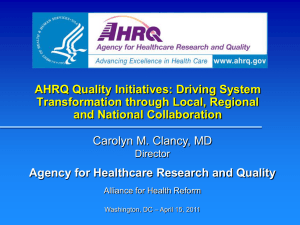An Asset-Based Approach to Asthma Education
advertisement
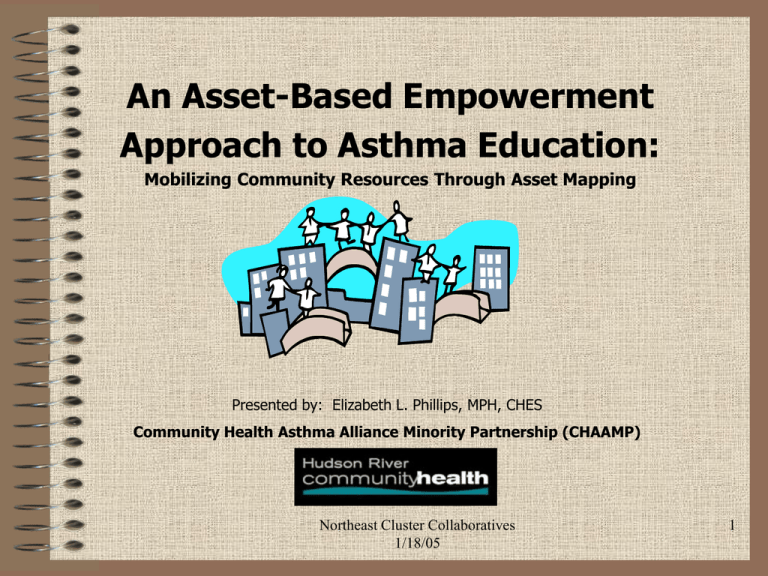
An Asset-Based Empowerment Approach to Asthma Education: Mobilizing Community Resources Through Asset Mapping Presented by: Elizabeth L. Phillips, MPH, CHES Community Health Asthma Alliance Minority Partnership (CHAAMP) Northeast Cluster Collaboratives 1/18/05 1 Learning Objectives • Learn how to incorporate an asset based approach to problem solving or enhance asthma health education efforts. • Understand the benefits of coalition building via the “asset-based” approach in the identification of individual skills and organizational/institutional resources. • Build familiarity with the process of asset-based mapping and its application towards public health efforts aimed at addressing health disparities among minority populations. Northeast Cluster Collaboratives 1/18/05 2 Project Background Project: Community Health Asthma Alliance Minority Partnership (CHAAMP) formerly the Dutchess County Minority Asthma Alliance established in 2000, a grassroots coalition focusing on individual and community level issues associated with the burden of this national epidemic. Lead Agency: Hudson River Community Health Coalition Membership: comprised of local agencies representatives, family members, health professionals and concerned individuals. Funding Source: NYS Department of Health - Office of Minority Health. Northeast Cluster Collaboratives 1/18/05 3 CHAAMP formerly the Dutchess County Minority Asthma Alliance Mission To improve health outcomes and increase access to comprehensive asthma care, support and services for African American and Latino children with asthma, by working within the community to overcome the daily barriers encountered by families residing in Peekskill, Beacon & Poughkeepsie. Northeast Cluster Collaboratives 1/18/05 4 Asset-Based Community Development • • ABCD is the assessment and mobilization of these resources. • An “asset map” is a display of the resources which can take place in various forms and media. Northeast Cluster Collaboratives 1/18/05 5 Asset Mapping • Seeing the glass half empty – Clients have deficiencies and needs • Seeing the glass half full – Individuals with gifts/talents Based on “Building Communities from the Inside Out” by John P. Kretzmann and John L,. McKnight as presented by Robert Francis, Executive Director of Regional Youth & Adult Substance Abuse Project (RYASAP) Bridgeport, CT. Northeast Cluster Collaboratives 1/18/05 6 Seeking Solutions Needs Assessment • Deficiency oriented identity • Sets a mood of hopelessness • Needs define the intervention • Destroys local relationships • Creates vicious funding cycle vs. Asset Mapping Affirms “gifts”on all levels Built on community strengths Thrives on community input Relationship driven Better use of external and internal resources Northeast Cluster Collaboratives 1/18/05 7 Community Assets Building Blocks Individual Residents Skills Experiences Knowledge Outreach & Advocacy e.g. Youth, Seniors, Low-income, Disabled Citizen Associations Outreach & Advocacy Visibility Marketing In-kind Support Technical Assistance Outreach & Advocacy e.g. Tenant Housing Council, Places of Worship, Artists, Merchants, Sports Groups Northeast Cluster Collaboratives 1/18/05 Institutions Outreach & Advocacy Visibility Marketing In-kind Support Technical Assistance e.g. Hospitals, School Districts, Universities & Libraries 8 Asset Mapping Process Helps to identify… • existing community resources & services • different communication strategies for working with community residents, organizations & coalition members • opportunities for the coalition to promote and tell their story • Prospective coalition members and allies Northeast Cluster Collaboratives 1/18/05 9 Benefits of Asset Mapping • • • • • • • Shift in power from professionals to community Inclusiveness -- everyone has gifts Relationship building People NOT programs overcome barriers Sustainability Smaller, but better results Focus on bridging resources by developing organizers and “gappers” Based on “Building Communities from the Inside Out” by John P. Kretzmann and John L,. McKnight as presented by Robert Francis, Executive Director of Regional Youth & Adult Substance Abuse Project Bridgeport, CT. Northeast Cluster Collaboratives 1/18/05 10 Our ABCD Experience in Community Health Education • Utilizing the asthma asset map and tapping into community member’s individual skills has increased the community’s access to culturally appropriate asthma education. Northeast Cluster Collaboratives 1/18/05 11 Assets in Action • • • • • • • • CBO’s Health Providers AmeriCorps/VISTA Citizens HeadStart/DayCare sites School Nurses Health Institutions Public Schools Northeast Cluster Collaboratives 1/18/05 12 Assets in Action HomeAIR is an educational & environmental approach to asthma management. Based on the Community Health Worker (CHW) model to provide outreach & asthma education via home visitation. A unique health intervention that focuses on the need of health center users--pediatric asthma patients and their families. The HomeAIR team is comprised of local community residents & AmeriCorps members. Northeast Cluster Collaboratives 1/18/05 13 Home Asthma Intervention Resources HomeAIR • HomeAIR is a project of Hudson River Community Health. An asthma care management intervention using the Community Health Worker model approach to conduct home visits. • Target Population: Parents/Caregivers of Community Health Center Pediatric Patients • The HomeAIR team is comprised of local community residents & AmeriCorps members referred to as “Asthma Care Partners”. • HomeAIR participants either self-refer or their Primary Care Provides identifies & refers the family. Northeast Cluster Collaboratives 1/18/05 14 HomeAIR Revisited Changes in Intervention Delivery: • HomeAIR needed to be responsive and flexible to families needs in a proactive manner. – – Flexibility in the delivery of HomeAIR services meant condensing home visit structure as necessary---by meeting with families on 2 visits instead of 3. Proactive in not relying on providers to refer families and enable parent to sign up directly. Changes in Data Collection Survey Pre survey questions were unclear to interviewer & the family members. Questions were reworded to make it more user friendly to improve the usefulness of the information. Data Collection Pre Survey Original Q. Does your child use a Peak Flow Meter? If yes :_____________predicted measurement ___________actual measurement Revised Q. Does your child use a Peak Flow Meter at home? If YES, what is their personal best reading? ________ OR______ I do not know. Northeast Cluster Collaboratives 1/18/05 15 HomeAIR Revisited Other Proposed Changes: Conduct group asthma education workshops—HomeAIR Forums. The sessions will be led by asthma care partners & Pediatric Department providers at the community health center (to be piloted in Fall 2004). HomeAIR Forums will be open to the general public The anticipated benefits for HomeAIR participants will be the group experience & exchange of information via facilitated discussion on the basics of asthma. Home AIR participants will then be offered the opportunity to sign up for a 1 time home assessment conducted by the asthma care partner. Incorporate participant evaluation of HomeAIR forums with pre/post tests. Home Assessments will be available to all participants; maintain use of pre/post asthma data collection surveys. Northeast Cluster Collaboratives 1/18/05 16 Chronic Care Model Components the community…CHAAMP Coalition self-management support… Home AIR Assessment the health system….BOD monthly reports; Strategic Plan; Use of PDSAs decision support…Asthma Action Plan clinical information systems…PECS as of 11/04 delivery system design…HomeAIR pilot, CHW’s Northeast Cluster Collaboratives 1/18/05 17 Roadblocks on the Journey • • • • • Resistance from deficit oriented people Competing initiatives Conflicting priorities Temptation to act alone Motivation & Uncertainty Northeast Cluster Collaboratives 1/18/05 18 Learn By Doing -stay positive & don’t give up -persevere, even if it doesn’t start out well -get people to see dream & make it come true -be willing to ask -feed the vision -innovation means taking risks establish trust and respect - establish a mission statement - motivation leads to sustainability - exchange assets - promote networking STAY FOCUSED TRUST THE PROCESS Northeast Cluster Collaboratives 1/18/05 19 Thank You. Mobilizing Community Resources Through Asset Mapping Presented by: Elizabeth L. Phillips, MPH, CHES Community Health Asthma Alliance Minority Partnership (CHAAMP) Northeast Cluster Collaboratives 1/18/05 20
